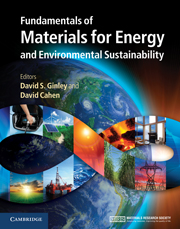Book contents
- Frontmatter
- Contents
- Contributors
- Preface
- Acknowledgments
- Part 1 Energy and the environment: the global landscape
- Part 2 Nonrenewable energy sources
- Part 3 Renewable energy sources
- 17 Solar energy overview
- 18 Direct solar energy conversion with photovoltaic devices
- 19 Future concepts for photovoltaic energy conversion
- 20 Concentrating and multijunction photovoltaics
- 21 Concentrating solar thermal power
- 22 Solar thermoelectrics: direct solar thermal energy conversion
- 23 Off-grid solar in the developing world
- 24 Principles of photosynthesis
- 25 Biofuels and biomaterials from microbes
- 26 Biofuels from cellulosic biomass via aqueous processing
- 27 Artificial photosynthesis for solar energy conversion
- 28 Engineering natural photosynthesis
- 29 Geothermal and ocean energy
- 30 Wind energy
- Part 4 Transportation
- Part 5 Energy efficiency
- Part 6 Energy storage, high-penetration renewables, and grid stabilization
- Summary
- Appendix A Thermodynamics
- Appendix B Electrochemistry
- Appendix C Units
- Index
- References
25 - Biofuels and biomaterials from microbes
from Part 3 - Renewable energy sources
Published online by Cambridge University Press: 05 June 2012
- Frontmatter
- Contents
- Contributors
- Preface
- Acknowledgments
- Part 1 Energy and the environment: the global landscape
- Part 2 Nonrenewable energy sources
- Part 3 Renewable energy sources
- 17 Solar energy overview
- 18 Direct solar energy conversion with photovoltaic devices
- 19 Future concepts for photovoltaic energy conversion
- 20 Concentrating and multijunction photovoltaics
- 21 Concentrating solar thermal power
- 22 Solar thermoelectrics: direct solar thermal energy conversion
- 23 Off-grid solar in the developing world
- 24 Principles of photosynthesis
- 25 Biofuels and biomaterials from microbes
- 26 Biofuels from cellulosic biomass via aqueous processing
- 27 Artificial photosynthesis for solar energy conversion
- 28 Engineering natural photosynthesis
- 29 Geothermal and ocean energy
- 30 Wind energy
- Part 4 Transportation
- Part 5 Energy efficiency
- Part 6 Energy storage, high-penetration renewables, and grid stabilization
- Summary
- Appendix A Thermodynamics
- Appendix B Electrochemistry
- Appendix C Units
- Index
- References
Summary
Focus
The development of “carbon-neutral” biofuels and biomaterials is critical for stabilizing atmospheric carbon dioxide levels and reducing the current dependence on petroleum. Microbes are self-replicating “biocatalytic” systems that can convert solar energy and plant biomass into a wide range of molecules that can be used for biofuels and biomaterials. However, major technical challenges need to be addressed before the approaches become economically viable. Among these challenges are the recalcitrance of lignocellulosic feedstocks, the low cell density of algal production systems, and the scaling needed to minimize impacts on freshwater/arable land.
Synopsis
Biofuels and biomaterials are among the diverse portfolio of technologies considered essential to address concerns over an excessive dependence on fossil fuels and their impact on the environment, such as through CO2 emissions. Whereas the burning of fossil fuels increases the amount of CO2 in the atmosphere, biofuels and biomaterials have the potential to be carbon neutral or negative. Because the carbon sequestered in biofuels is eventually returned to the atmosphere upon burning, these are primarily carbon-neutral technologies, although some crops accumulate carbon in the soil and have the potential to be carbon-negative. The use of biomaterials, on the other hand, can decrease the atmospheric concentration of carbon dioxide by fixing it in useful materials.
- Type
- Chapter
- Information
- Publisher: Cambridge University PressPrint publication year: 2011

